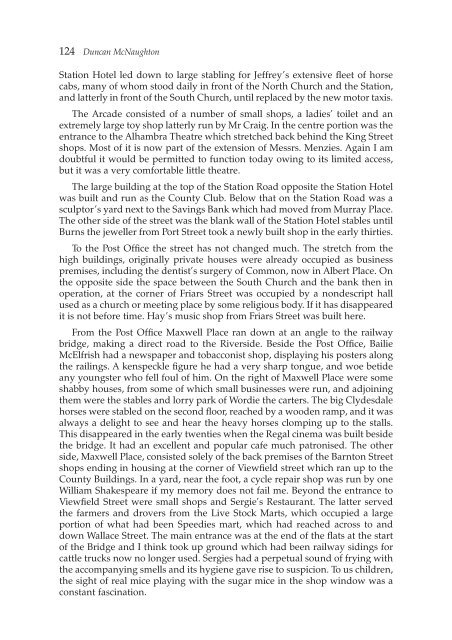the Forth Naturalist Historian - Forth Naturalist and Historian ...
the Forth Naturalist Historian - Forth Naturalist and Historian ...
the Forth Naturalist Historian - Forth Naturalist and Historian ...
You also want an ePaper? Increase the reach of your titles
YUMPU automatically turns print PDFs into web optimized ePapers that Google loves.
124 Duncan McNaughton<br />
Station Hotel led down to large stabling for Jeffrey’s extensive fleet of horse<br />
cabs, many of whom stood daily in front of <strong>the</strong> North Church <strong>and</strong> <strong>the</strong> Station,<br />
<strong>and</strong> latterly in front of <strong>the</strong> South Church, until replaced by <strong>the</strong> new motor taxis.<br />
The Arcade consisted of a number of small shops, a ladies’ toilet <strong>and</strong> an<br />
extremely large toy shop latterly run by Mr Craig. In <strong>the</strong> centre portion was <strong>the</strong><br />
entrance to <strong>the</strong> Alhambra Theatre which stretched back behind <strong>the</strong> King Street<br />
shops. Most of it is now part of <strong>the</strong> extension of Messrs. Menzies. Again I am<br />
doubtful it would be permitted to function today owing to its limited access,<br />
but it was a very comfortable little <strong>the</strong>atre.<br />
The large building at <strong>the</strong> top of <strong>the</strong> Station Road opposite <strong>the</strong> Station Hotel<br />
was built <strong>and</strong> run as <strong>the</strong> County Club. Below that on <strong>the</strong> Station Road was a<br />
sculptor’s yard next to <strong>the</strong> Savings Bank which had moved from Murray Place.<br />
The o<strong>the</strong>r side of <strong>the</strong> street was <strong>the</strong> blank wall of <strong>the</strong> Station Hotel stables until<br />
Burns <strong>the</strong> jeweller from Port Street took a newly built shop in <strong>the</strong> early thirties.<br />
To <strong>the</strong> Post Office <strong>the</strong> street has not changed much. The stretch from <strong>the</strong><br />
high buildings, originally private houses were already occupied as business<br />
premises, including <strong>the</strong> dentist’s surgery of Common, now in Albert Place. On<br />
<strong>the</strong> opposite side <strong>the</strong> space between <strong>the</strong> South Church <strong>and</strong> <strong>the</strong> bank <strong>the</strong>n in<br />
operation, at <strong>the</strong> corner of Friars Street was occupied by a nondescript hall<br />
used as a church or meeting place by some religious body. If it has disappeared<br />
it is not before time. Hay’s music shop from Friars Street was built here.<br />
From <strong>the</strong> Post Office Maxwell Place ran down at an angle to <strong>the</strong> railway<br />
bridge, making a direct road to <strong>the</strong> Riverside. Beside <strong>the</strong> Post Office, Bailie<br />
McElfrish had a newspaper <strong>and</strong> tobacconist shop, displaying his posters along<br />
<strong>the</strong> railings. A kenspeckle figure he had a very sharp tongue, <strong>and</strong> woe betide<br />
any youngster who fell foul of him. On <strong>the</strong> right of Maxwell Place were some<br />
shabby houses, from some of which small businesses were run, <strong>and</strong> adjoining<br />
<strong>the</strong>m were <strong>the</strong> stables <strong>and</strong> lorry park of Wordie <strong>the</strong> carters. The big Clydesdale<br />
horses were stabled on <strong>the</strong> second floor, reached by a wooden ramp, <strong>and</strong> it was<br />
always a delight to see <strong>and</strong> hear <strong>the</strong> heavy horses clomping up to <strong>the</strong> stalls.<br />
This disappeared in <strong>the</strong> early twenties when <strong>the</strong> Regal cinema was built beside<br />
<strong>the</strong> bridge. It had an excellent <strong>and</strong> popular cafe much patronised. The o<strong>the</strong>r<br />
side, Maxwell Place, consisted solely of <strong>the</strong> back premises of <strong>the</strong> Barnton Street<br />
shops ending in housing at <strong>the</strong> corner of Viewfield street which ran up to <strong>the</strong><br />
County Buildings. In a yard, near <strong>the</strong> foot, a cycle repair shop was run by one<br />
William Shakespeare if my memory does not fail me. Beyond <strong>the</strong> entrance to<br />
Viewfield Street were small shops <strong>and</strong> Sergie’s Restaurant. The latter served<br />
<strong>the</strong> farmers <strong>and</strong> drovers from <strong>the</strong> Live Stock Marts, which occupied a large<br />
portion of what had been Speedies mart, which had reached across to <strong>and</strong><br />
down Wallace Street. The main entrance was at <strong>the</strong> end of <strong>the</strong> flats at <strong>the</strong> start<br />
of <strong>the</strong> Bridge <strong>and</strong> I think took up ground which had been railway sidings for<br />
cattle trucks now no longer used. Sergies had a perpetual sound of frying with<br />
<strong>the</strong> accompanying smells <strong>and</strong> its hygiene gave rise to suspicion. To us children,<br />
<strong>the</strong> sight of real mice playing with <strong>the</strong> sugar mice in <strong>the</strong> shop window was a<br />
constant fascination.



